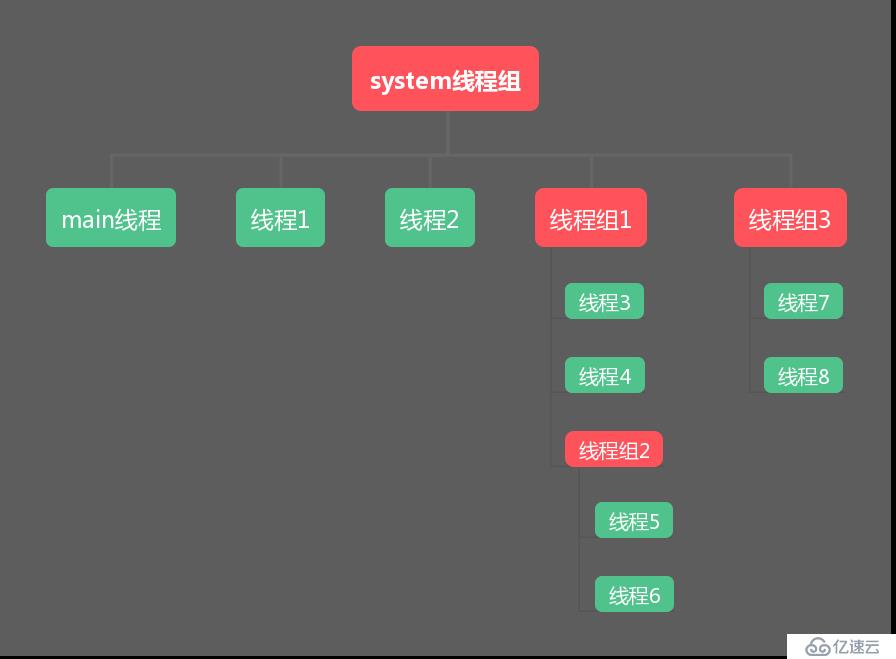您好,登錄后才能下訂單哦!
您好,登錄后才能下訂單哦!
我們可以把線程歸屬到某個線程組中,線程組可以包含多個線程以及線程組,線程和線程組組成了父子關系,是個樹形結構,如下圖:

使用線程組可以方便管理線程,線程組提供了一些方法方便方便我們管理線程。
創建線程的時候,可以給線程指定一個線程組,代碼如下:
package com.itsoku.chat02;
import java.util.concurrent.TimeUnit;
/**
* <b>description</b>: <br>
* <b>time</b>:2019/7/13 17:53 <br>
* <b>author</b>:微信公眾號:路人甲Java,專注于java技術分享(帶你玩轉 爬蟲、分布式事務、異步消息服務、任務調度、分庫分表、大數據等),喜歡請關注!
*/
public class Demo1 {
public static class R1 implements Runnable {
@Override
public void run() {
System.out.println("threadName:" + Thread.currentThread().getName());
try {
TimeUnit.SECONDS.sleep(3);
} catch (InterruptedException e) {
e.printStackTrace();
}
}
}
public static void main(String[] args) throws InterruptedException {
ThreadGroup threadGroup = new ThreadGroup("thread-group-1");
Thread t1 = new Thread(threadGroup, new R1(), "t1");
Thread t2 = new Thread(threadGroup, new R1(), "t2");
t1.start();
t2.start();
TimeUnit.SECONDS.sleep(1);
System.out.println("活動線程數:" + threadGroup.activeCount());
System.out.println("活動線程組:" + threadGroup.activeGroupCount());
System.out.println("線程組名稱:" + threadGroup.getName());
}
}輸出結果:
threadName:t1
threadName:t2
活動線程數:2
活動線程組:0
線程組名稱:thread-group-1activeCount()方法可以返回線程組中的所有活動線程數,包含下面的所有子孫節點的線程,由于線程組中的線程是動態變化的,這個值只能是一個估算值。
創建線程組的時候,可以給其指定一個父線程組,也可以不指定,如果不指定父線程組,則父線程組為當前線程的線程組,java api有2個常用的構造方法用來創建線程組:
public ThreadGroup(String name)
public ThreadGroup(ThreadGroup parent, String name)第一個構造方法未指定父線程組,看一下內部的實現:
public ThreadGroup(String name) {
this(Thread.currentThread().getThreadGroup(), name);
}系統自動獲取當前線程的線程組作為默認父線程組。
上一段示例代碼:
package com.itsoku.chat02;
import java.util.concurrent.TimeUnit;
/**
* <b>description</b>: <br>
* <b>time</b>:2019/7/13 17:53 <br>
* <b>author</b>:微信公眾號:路人甲Java,專注于java技術分享(帶你玩轉 爬蟲、分布式事務、異步消息服務、任務調度、分庫分表、大數據等),喜歡請關注!
*/
public class Demo2 {
public static class R1 implements Runnable {
@Override
public void run() {
Thread thread = Thread.currentThread();
System.out.println("所屬線程組:" + thread.getThreadGroup().getName() + ",線程名稱:" + thread.getName());
try {
TimeUnit.SECONDS.sleep(3);
} catch (InterruptedException e) {
e.printStackTrace();
}
}
}
public static void main(String[] args) throws InterruptedException {
ThreadGroup threadGroup1 = new ThreadGroup("thread-group-1");
Thread t1 = new Thread(threadGroup1, new R1(), "t1");
Thread t2 = new Thread(threadGroup1, new R1(), "t2");
t1.start();
t2.start();
TimeUnit.SECONDS.sleep(1);
System.out.println("threadGroup1活動線程數:" + threadGroup1.activeCount());
System.out.println("threadGroup1活動線程組:" + threadGroup1.activeGroupCount());
System.out.println("threadGroup1線程組名稱:" + threadGroup1.getName());
System.out.println("threadGroup1父線程組名稱:" + threadGroup1.getParent().getName());
System.out.println("----------------------");
ThreadGroup threadGroup2 = new ThreadGroup(threadGroup1, "thread-group-2");
Thread t3 = new Thread(threadGroup2, new R1(), "t3");
Thread t4 = new Thread(threadGroup2, new R1(), "t4");
t3.start();
t4.start();
TimeUnit.SECONDS.sleep(1);
System.out.println("threadGroup2活動線程數:" + threadGroup2.activeCount());
System.out.println("threadGroup2活動線程組:" + threadGroup2.activeGroupCount());
System.out.println("threadGroup2線程組名稱:" + threadGroup2.getName());
System.out.println("threadGroup2父線程組名稱:" + threadGroup2.getParent().getName());
System.out.println("----------------------");
System.out.println("threadGroup1活動線程數:" + threadGroup1.activeCount());
System.out.println("threadGroup1活動線程組:" + threadGroup1.activeGroupCount());
System.out.println("----------------------");
threadGroup1.list();
}
}輸出結果:
所屬線程組:thread-group-1,線程名稱:t1
所屬線程組:thread-group-1,線程名稱:t2
threadGroup1活動線程數:2
threadGroup1活動線程組:0
threadGroup1線程組名稱:thread-group-1
threadGroup1父線程組名稱:main
----------------------
所屬線程組:thread-group-2,線程名稱:t4
所屬線程組:thread-group-2,線程名稱:t3
threadGroup2活動線程數:2
threadGroup2活動線程組:0
threadGroup2線程組名稱:thread-group-2
threadGroup2父線程組名稱:thread-group-1
----------------------
threadGroup1活動線程數:4
threadGroup1活動線程組:1
----------------------
java.lang.ThreadGroup[name=thread-group-1,maxpri=10]
Thread[t1,5,thread-group-1]
Thread[t2,5,thread-group-1]
java.lang.ThreadGroup[name=thread-group-2,maxpri=10]
Thread[t3,5,thread-group-2]
Thread[t4,5,thread-group-2]代碼解釋:
獲取根線程組
package com.itsoku.chat02;
/**
* <b>description</b>: <br>
* <b>time</b>:2019/7/13 17:53 <br>
* <b>author</b>:微信公眾號:路人甲Java,專注于java技術分享(帶你玩轉 爬蟲、分布式事務、異步消息服務、任務調度、分庫分表、大數據等),喜歡請關注!
*/
public class Demo3 {
public static void main(String[] args) {
System.out.println(Thread.currentThread());
System.out.println(Thread.currentThread().getThreadGroup());
System.out.println(Thread.currentThread().getThreadGroup().getParent());
System.out.println(Thread.currentThread().getThreadGroup().getParent().getParent());
}
}運行上面代碼,輸出:
Thread[main,5,main]
java.lang.ThreadGroup[name=main,maxpri=10]
java.lang.ThreadGroup[name=system,maxpri=10]
null從上面代碼可以看出:
看一下ThreadGroup的源碼:
private ThreadGroup() { // called from C code
this.name = "system";
this.maxPriority = Thread.MAX_PRIORITY;
this.parent = null;
}發現ThreadGroup默認構造方法是private的,是由c調用的,創建的正是system線程組。
調用線程組interrupt(),會將線程組樹下的所有子孫線程中斷標志置為true,可以用來批量中斷線程。
示例代碼:
package com.itsoku.chat02;
import java.util.concurrent.TimeUnit;
/**
* <b>description</b>: <br>
* <b>time</b>:2019/7/13 17:53 <br>
* <b>author</b>:微信公眾號:路人甲Java,專注于java技術分享(帶你玩轉 爬蟲、分布式事務、異步消息服務、任務調度、分庫分表、大數據等),喜歡請關注!
*/
public class Demo4 {
public static class R1 implements Runnable {
@Override
public void run() {
Thread thread = Thread.currentThread();
System.out.println("所屬線程組:" + thread.getThreadGroup().getName() + ",線程名稱:" + thread.getName());
while (!thread.isInterrupted()) {
;
}
System.out.println("線程:" + thread.getName() + "停止了!");
}
}
public static void main(String[] args) throws InterruptedException {
ThreadGroup threadGroup1 = new ThreadGroup("thread-group-1");
Thread t1 = new Thread(threadGroup1, new R1(), "t1");
Thread t2 = new Thread(threadGroup1, new R1(), "t2");
t1.start();
t2.start();
ThreadGroup threadGroup2 = new ThreadGroup(threadGroup1, "thread-group-2");
Thread t3 = new Thread(threadGroup2, new R1(), "t3");
Thread t4 = new Thread(threadGroup2, new R1(), "t4");
t3.start();
t4.start();
TimeUnit.SECONDS.sleep(1);
System.out.println("-----------threadGroup1信息-----------");
threadGroup1.list();
System.out.println("----------------------");
System.out.println("停止線程組:" + threadGroup1.getName() + "中的所有子孫線程");
threadGroup1.interrupt();
TimeUnit.SECONDS.sleep(2);
System.out.println("----------threadGroup1停止后,輸出信息------------");
threadGroup1.list();
}
}輸出:
所屬線程組:thread-group-1,線程名稱:t1
所屬線程組:thread-group-1,線程名稱:t2
所屬線程組:thread-group-2,線程名稱:t3
所屬線程組:thread-group-2,線程名稱:t4
-----------threadGroup1信息-----------
java.lang.ThreadGroup[name=thread-group-1,maxpri=10]
Thread[t1,5,thread-group-1]
Thread[t2,5,thread-group-1]
java.lang.ThreadGroup[name=thread-group-2,maxpri=10]
Thread[t3,5,thread-group-2]
Thread[t4,5,thread-group-2]
----------------------
停止線程組:thread-group-1中的所有子孫線程
線程:t4停止了!
線程:t2停止了!
線程:t1停止了!
線程:t3停止了!
----------threadGroup1停止后,輸出信息------------
java.lang.ThreadGroup[name=thread-group-1,maxpri=10]
java.lang.ThreadGroup[name=thread-group-2,maxpri=10]停止線程之后,通過list()方法可以看出輸出的信息中不包含已結束的線程了。
多說幾句,建議大家再創建線程或者線程組的時候,給他們取一個有意義的名字,對于計算機來說,可能名字并不重要,但是在系統出問題的時候,你可能會去查看線程堆棧信息,如果你看到的都是t1、t2、t3,估計自己也比較崩潰,如果看到的是httpAccpHandler、dubboHandler類似的名字,應該會好很多。
java高并發系列連載中,總計估計會有四五十篇文章,可以關注公眾號:javacode2018,獲取最新文章。

免責聲明:本站發布的內容(圖片、視頻和文字)以原創、轉載和分享為主,文章觀點不代表本網站立場,如果涉及侵權請聯系站長郵箱:is@yisu.com進行舉報,并提供相關證據,一經查實,將立刻刪除涉嫌侵權內容。